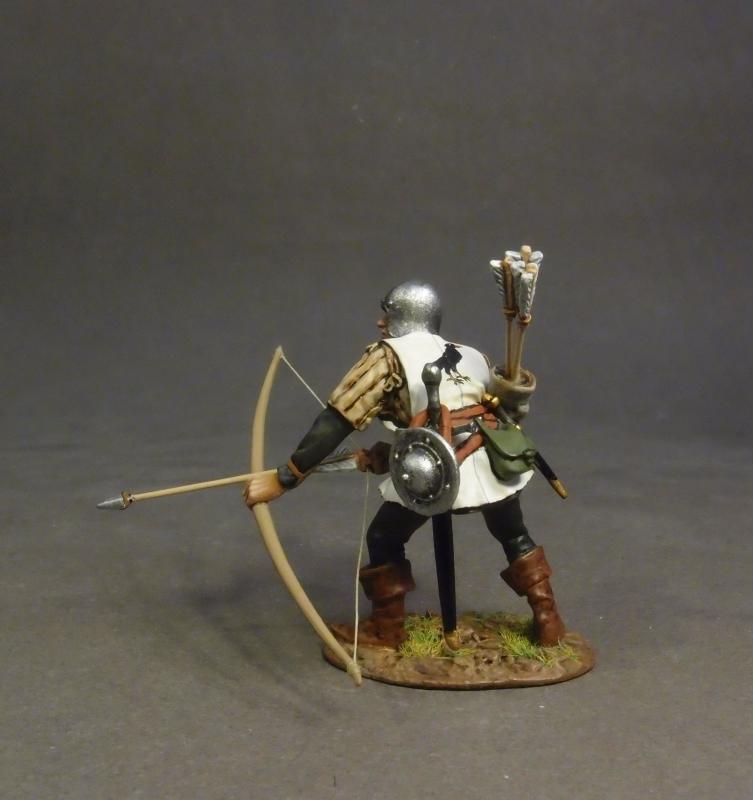Lancastrian Archer #3, The Battle of Bosworth Field, 1485, The Wars of the Roses, 1455-1487—single figure
$43.00
Item Number: RTLANC-11
Lancastrian Archer #3, The Battle of Bosworth Field, 1485, The Wars of the Roses, 1455-1487
Henry's and Rhys's forces marched separately through Wales, with Rhys recruiting 500 men as he proceeded. They rejoined at Welshpool before crossing into England. Rhys's Welsh force was described as being large enough to have "annihilated" the rest of Henry's army. On 22 August, they met Richard's army near Market Bosworth. In the resulting Battle of Bosworth, Richard launched an attack led by John Howard, 1st Duke of Norfolk. According to a contemporary ballad, Rhys's men halted the assault. "Norfolk's line began to break under pressure from Rhys ap Thomas's men" and the Duke was killed by an arrow shot. Hoping to turn the tide and win the battle rapidly by killing his rival, Richard and his companion knights charged directly at Henry. The king was unhorsed and surrounded. The poet Guto'r Glyn implies that Rhys himself was responsible for killing Richard, possibly with a pole axe. Referring to Richard's emblem of a boar, the poet writes that Rhys "killed the boar, shaved his head" ("Lladd y baedd, eilliodd ei ben"). However, this may only mean that one of Rhys's Welsh halberdiers killed the king, since the Burgundian chronicler Jean Molinet, says that a Welshman, one of Rhys' men suspected to be Wyllyam Gardynyr, struck the death-blow with a halberd. Guto'r Glyn himself says that Rhys was "like the stars of a shield with the spear in their midst on a great steed" ("A Syr Rys mal sŷr aesaw, Â’r gwayw’n eu mysg ar gnyw mawr"). He was knighted on the field of battle.
THE WARS OF THE ROSES 1455-1487
The Wars of the Roses were a series of dynastic wars for the throne of England. They were fought between supporters of two rival branches of the royal House of Plantagenet, the houses of Lancaster and York. They were fought in several sporadic episodes between 1455 and 1487, although there was related fighting before and after this period. The conflict resulted from social and financial troubles that followed the Hundred Years' War, combined with the mental infirmity and weak rule of Henry VI, which revived interest in the alternative claim to the throne of Richard, Duke of York.
The final victory went to a claimant of the Lancastrian party, Henry Tudor, who defeated the last Yorkist king, Richard III, at the Battle of Bosworth Field. After assuming the throne as Henry VII, Henry Tudor married Elizabeth of York, the eldest daughter and heiress of Edward IV, thereby uniting the two claims. The House of Tudor ruled England and Wales until 1603.
THE BATTLE OF BOSWORTH FIELD, 1485
The Battle of Bosworth (or Bosworth Field) was the last significant battle of the Wars of the Roses, the civil war between the Houses of Lancaster and York that raged across England in the latter half of the 15th century. Fought on 22 August 1485, the battle was won by the Lancastrians. Their leader Henry Tudor, Earl of Richmond, by his victory became the first English monarch of the Tudor dynasty. His opponent, Richard III, the last king of the House of York, was killed in the battle. Historians consider Bosworth Field to mark the end of the Plantagenet dynasty, making it a defining moment of English and Welsh history.
The Lancastrian Army
Having not fought in any battles, Henry Tudor was not regarded as much of a warrior. Chroniclers of the period found him more interested in commerce and finance. Having spent the first fourteen years of his life in Wales and the next fourteen in Brittany and France, Henry Tudor was therefore unfamiliar with the arts of war and a stranger to the land he was trying to conquer. But he was known as being strong and decisive.
Henry recruited several experienced veterans on whom he could rely for military advice and the command of his armies, most notably John de Vere, 13th Earl of Oxford, who was Henry's principal military commander.
Henry Tudor decided to commit most of his small force into one single large division or “battle” and place it under the command of the Earl of Oxford.

